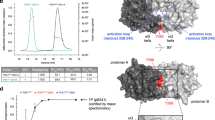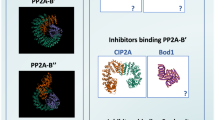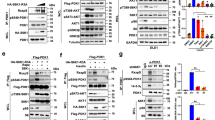Abstract
Many extracellular signals stimulate phosphatidylinositol-3-kinase, which in turn activates the Rac1 GTPase, the protein kinase Akt and the Akt Thr 308 upstream kinase PDK1. Active Rac1 stimulates a number of events, including substrate phosphorylation by a subgroup of the PAK family of kinases. The combined effects of Rac1, PDK1 and Akt are crucial for cell migration, growth, survival, metabolism and tumorigenesis. Here we show that Rac1 stimulates a second, kinase-independent function of PAK1. The PAK1 kinase domain serves as a scaffold to facilitate Akt stimulation by PDK1 and to aid recruitment of Akt to the membrane. PAK differentially activates subpopulations of Akt. These findings reveal scaffolding functions of PAK that regulate the efficiency, localization and specificity of the PDK1–Akt pathway.
This is a preview of subscription content, access via your institution
Access options
Subscribe to this journal
Receive 12 print issues and online access
$209.00 per year
only $17.42 per issue
Buy this article
- Purchase on Springer Link
- Instant access to full article PDF
Prices may be subject to local taxes which are calculated during checkout





Similar content being viewed by others
References
Cantley, L. C. The phosphoinositide 3-kinase pathway. Science 296, 1655–1657 (2002).
Nobes, C. D., Hawkins, P., Stephens, L. & Hall, A. Activation of the small GTP-binding proteins rho and rac by growth factor receptors. J. Cell Sci. 108, 225–233 (1995).
Nobes, C. D. & Hall, A. Rho, rac, and cdc42 GTPases regulate the assembly of multimolecular focal complexes associated with actin stress fibers, lamellipodia, and filopodia. Cell 81, 53–62 (1995).
Bokoch, G. M. Biology of the p21-activated kinases. Annu. Rev. Biochem. 72, 743–781 (2003).
Manser, E., Leung, T., Salihuddin, H., Zhao, Z. S. & Lim, L. A brain serine/threonine protein kinase activated by Cdc42 and Rac1. Nature 367, 40–46 (1994).
Frost, J. A., Khokhlatchev, A., Stippec, S., White, M. A. & Cobb, M. H. Differential effects of PAK1-activating mutations reveal activity-dependent and -independent effects on cytoskeletal regulation. J. Biol. Chem. 273, 28191–28198 (1998).
Sells, M. A., Boyd, J. T. & Chernoff, J. p21-activated kinase 1 (Pak1) regulates cell motility in mammalian fibroblasts. J. Cell Biol. 145, 837–849 (1999).
Higuchi, M., Masuyama, N., Fukui, Y., Suzuki, A. & Gotoh, Y. Akt mediates Rac/Cdc42-regulated cell motility in growth factor-stimulated cells and in invasive PTEN knockout cells. Curr. Biol. 11, 1958–1962 (2001).
Alessi, D. R. et al. Characterization of a 3-phosphoinositide-dependent protein kinase which phosphorylates and activates protein kinase Bα. Curr. Biol. 7, 261–269 (1997).
Sarbassov, D. D., Guertin, D. A., Ali, S. M. & Sabatini, D. M. Phosphorylation and regulation of Akt/PKB by the rictor-mTOR complex. Science 307, 1098–1101 (2005).
Kohn, A. D., Takeuchi, F. & Roth, R. A. Akt, a pleckstrin homology domain containing kinase, is activated primarily by phosphorylation. J. Biol. Chem. 271, 21920–21926 (1996).
Owen, D., Mott, H. R., Laue, E. D. & Lowe, P. N. Residues in Cdc42 that specify binding to individual CRIB effector proteins. Biochemistry 39, 1243–1250 (2000).
Gorlach, A., BelAiba, R. S., Hess, J. & Kietzmann, T. Thrombin activates the p21-activated kinase in pulmonary artery smooth muscle cells. Role in tissue factor expression. Thromb. Haemost. 93, 1168–1175 (2005).
Mao, K. et al. Regulation of Akt/PKB activity by P21-activated kinase in cardiomyocytes. J. Mol. Cell. Cardiol. 44, 429–344 (2008).
Scheid, M. P., Marignani, P. A. & Woodgett, J. R. Multiple phosphoinositide 3-kinase-dependent steps in activation of protein kinase B. Mol. Cell. Biol. 22, 6247–6260 (2002).
King, C. C. et al. p21-activated kinase (PAK1) is phosphorylated and activated by 3-phosphoinositide-dependent kinase-1 (PDK1). J. Biol. Chem. 275, 41201–41209 (2000).
Wang, Q. et al. Protein kinase B/Akt participates in GLUT4 translocation by insulin in L6 myoblasts. Mol. Cell. Biol. 19, 4008–4018 (1999).
Reeder, M. K., Serebriiskii, I. G., Golemis, E. A. & Chernoff, J. Analysis of small GTPase signaling pathways using p21-activated kinase mutants that selectively couple to Cdc42. J. Biol. Chem. 276, 40606–40613 (2001).
Joneson, T., White, M. A., Wigler, M. H. & Bar-Sagi, D. Stimulation of membrane ruffling and MAP kinase activation by distinct effectors of RAS. Science 271, 810–812 (1996).
Lamarche, N. et al. Rac and Cdc42 induce actin polymerization and G1 cell cycle progression independently of p65PAK and the JNK/SAPK MAP kinase cascade. Cell 87, 519–529 (1996).
Irie, H. Y. et al. Distinct roles of Akt1 and Akt2 in regulating cell migration and epithelial–mesenchymal transition. J. Cell Biol. 171, 1023–1034 (2005).
Yoeli-Lerner, M. et al. Akt blocks breast cancer cell motility and invasion through the transcription factor NFAT. Mol. Cell 20, 539–550 (2005).
Zhou, G. L. et al. Opposing roles for Akt1 and Akt2 in Rac/Pak signaling and cell migration. J. Biol. Chem. 281, 36443–36453 (2006).
Brazil, D. P., Yang, Z. Z. & Hemmings, B. A. Advances in protein kinase B signalling: AKTion on multiple fronts. Trends Biochem. Sci. 29, 233–242 (2004).
Woodgett, J. R. Recent advances in the protein kinase B signaling pathway. Curr. Opin. Cell Biol. 17, 150–157 (2005).
Zhou, G. L. et al. Akt phosphorylation of serine 21 on Pak1 modulates Nck binding and cell migration. Mol. Cell. Biol. 23, 8058–8069 (2003).
Higuchi, M., Onishi, K., Masuyama, N. & Gotoh, Y. The phosphatidylinositol-3 kinase (PI(3)K)–Akt pathway suppresses neurite branch formation in NGF-treated PC12 cells. Genes Cells 8, 657–669 (2003).
Lei, M. et al. Structure of PAK1 in an autoinhibited conformation reveals a multistage activation switch. Cell 102, 387–397 (2000).
Jakobi, R., McCarthy, C. C. & Koeppel, M. A. Mammalian expression vectors for epitope tag fusion proteins that are toxic in E. coli. Biotechniques 33, 1218–1222 (2002).
Lei, M., Robinson, M. A. & Harrison, S. C. The active conformation of the PAK1 kinase domain. Structure 13, 769–778 (2005).
Acknowledgements
We thank Jonathan A. Cooper, Michael E. Greenberg and members of the Gotoh Laboratory for critical reading of the manuscript, encouragement and helpful discussion. We also thank Michael E. Greenberg and Steve M. Shamah for phosphorylated Bad antibody and phosphorylated PAK1 antibody, and Masaki Inagaki for PAK construct. This work was supported in part by Grants-Aid from the Ministry of Education, Science, Sports and Culture of Japan, SORST of the Japan Science and Technology Corporation, Global COE Program (Integrative Life Science Based on the Study of Biosignaling Mechanisms), MEXT, the Mitsubishi Foundation, the Uehara Foundation and the Princess Takamatsu Foundation.
Author information
Authors and Affiliations
Contributions
M.H. and K.O. performed all the experiments and analysed the data; C.Y. assisted with the experiments shown in Supplementary Information, Fig. S5b; Y.G. supervised the study.
Corresponding author
Ethics declarations
Competing interests
The authors declare no competing financial interests.
Supplementary information
Supplementary Information
Supplementary Information (PDF 4422 kb)
Rights and permissions
About this article
Cite this article
Higuchi, M., Onishi, K., Kikuchi, C. et al. Scaffolding function of PAK in the PDK1–Akt pathway. Nat Cell Biol 10, 1356–1364 (2008). https://doi.org/10.1038/ncb1795
Received:
Accepted:
Published:
Issue Date:
DOI: https://doi.org/10.1038/ncb1795
This article is cited by
-
PAK and PI3K pathway activation confers resistance to KRASG12C inhibitor sotorasib
British Journal of Cancer (2023)
-
PLEKHG5 is stabilized by HDAC2-related deacetylation and confers sorafenib resistance in hepatocellular carcinoma
Cell Death Discovery (2023)
-
YB-1 activating cascades as potential targets in KRAS-mutated tumors
Strahlentherapie und Onkologie (2023)
-
Comprehensive analysis of the prognostic implications and functional exploration of PAK gene family in human cancer
Cancer Cell International (2022)
-
Blockage of PAK1 alleviates the proliferation and invasion of NSCLC cells via inhibiting ERK and AKT signaling activity
Clinical and Translational Oncology (2021)



